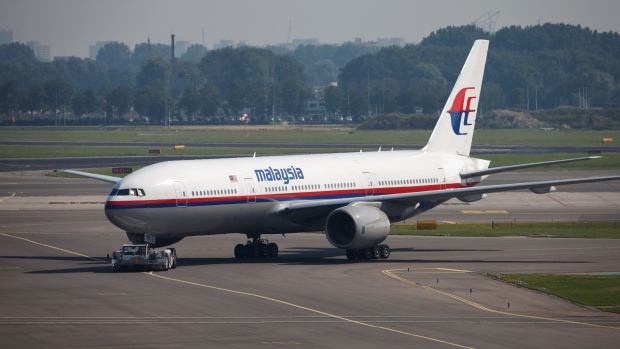The Boeing 777 jet is almost as long as a Manhattan city block and taller than a five-story building. Photographer: Jasper Juinen/Bloomberg , Bloomberg
(Bloomberg) — “Good Night. Malaysian Three Seven Zero.”
Those six words were the last radio transmission from the cockpit of Malaysia Airlines Flight 370, less than an hour after the aircraft took off late at night from Kuala Lumpur to Beijing on March 8, 2014. Minutes later, the plane disappeared from air-traffic control radar screens.
The huge Boeing Co. 777 jet, almost as long as a Manhattan city block and taller than a five-story building, had somehow managed to make itself invisible in the clear night sky. There were 239 people on board.
Ensuing search operations combed through some of the deepest ocean floors in the inhospitable southern Indian Ocean, hundreds of miles off Australia’s western seaboard, and found no trace of the main fuselage or any passengers and crew. Of the 3 million components in the 777, just a few fragments washed ashore years later on the east African coast.
Listen to the Big Take podcast on iHeart, Apple Podcasts, Spotify and the Bloomberg Terminal. Read the transcript.

With no mayday call, no known flight path and no wreckage, MH370 remains modern aviation’s biggest mystery. And while investigators had very little to go on, they were clear on one thing: A plane must never go missing like this again.
Yet 10 years on, an industrywide push to rule out a similar case has been stymied by bureaucracy, financial pressure, and a debate about who should have ultimate control of the cockpit, according to years of regulatory amendments chronicling the process.
A key aircraft-tracking tool that was proposed by Malaysian authorities weeks after the disaster is yet to be implemented. While the industry has saved hundreds of millions of dollars in equipment costs, there remains an ocean-sized hole in aviation’s safety protocols, meaning that a doomed passenger jet in a remote corner of the planet could remain hidden forever.
As search teams looked in vain for MH370, an additional layer of safety regulation spearheaded by the International Civil Aviation Organization proposed new jets should broadcast their position at least every minute if they were in trouble. The aim was to give authorities early warning of an unfolding disaster. Should the plane later go down, rescue teams would at least have a chance of locating the crash site.
It hasn’t turned out that way. The one-minute tracking rule has twice been delayed. It was initially due to be in force in January 2021 but is now set to take effect from January 2025. Bloomberg News asked more than a dozen major airlines spanning the US, Europe, the Middle East and Asia how many planes in their fleets already meet ICAO’s requirements. At the airlines that responded, very few planes are compliant.
Air France, which had more than 250 aircraft as of September, said seven jets — all Airbus SE A350s — comply with the standard. Korean Air Lines Co. said three of its 159-strong fleet are equipped with the tracking device, while Japan Airlines Co. said two of its 226 planes have the technology installed.

The delay since MH370 vanished has been unacceptable, said Hassan Shahidi, president and chief executive officer of the Flight Safety Foundation, a Virginia-based not-for-profit group that promotes aviation safety standards. “This was a tragedy and solutions have been developed. It is absolutely imperative that we take this final step,” Shahidi said.
As well as being years late, the fresh tracking standard applies only to new aircraft. There’s no requirement to install the relevant technology on more than 20,000 older planes in service as of last year. That means thousands of aircraft will fly for decades, ferrying millions of passengers around the world, without a capability that was deemed crucial after MH370 disappeared.
Technology hurdles have played at least some role in the delays. When the US National Transportation Safety Board recommended “tamper-proof” tracking systems on planes in 2015, the Federal Aviation Administration, considered the global pacesetter for the civil aviation industry, pushed back. The FAA said it couldn’t be done without sacrificing the pilot’s control of all systems, considered a mainstay of aviation safety protocols because pilots should have final say over the aircraft in case of emergencies.
The role of MH370 Captain Zaharie Ahmad Shah has been a major focus point of the mystery. According to the presumed sequence of events in the final report, the plane deliberately left its planned route north to China, looped back over Malaysia and headed out to sea. It cruised south for about six hours and probably came down in the southern Indian Ocean when it ran out of fuel.
Scientists managed to roughly map the doomed jet’s route by studying its hourly connections with a satellite 36,000 kilometers (22,400 miles) above Earth. As remarkable as this detective work was, it produced an enormous potential crash zone. An international search fleet surveyed 710,000 square kilometers of seabed, peppered with trenches and peaks, before the hunt was called off in 2017. A fresh effort the following year by marine exploration company Ocean Infinity also came up empty.
The forensic detail included in the 450-page final report into the tragedy makes it hard to escape the human toll of the tragedy. The report lists the seat number, gender and nationality of the passengers. The economy section was almost full, two children sat in 17F and 18F and another in 30H, and there were two infants on board. In the rear, four rows apart, two Iranians were traveling on stolen European passports.
The business-class section was barely one-third occupied, with most of the 10 passengers seated by the windows. The 10 flight attendants tending to their guests all came from Malaysia, while the majority of passengers were Chinese. Just after 1 a.m., the flight had settled into cruising altitude of 35,000 feet. Some 20 minutes later, MH370 signed off from Malaysian air-traffic control with its last-ever voice transmission.
Investigators said it’s possible someone then switched off the plane’s communications systems, while stopping short of a definitive conclusion. The team was “unable to determine the real cause for the disappearance of MH370,” they said.
At the same time, the report made an impassioned appeal to the international aviation community, saying it “needs to provide assurance to the traveling public that the location of current-generation commercial aircraft is always known. It is unacceptable to do otherwise.”
The one-minute tracking rule was designed to resolve that blind spot, by aiming to nail down a crash site to within a radius of six nautical miles.
That’s still not good enough, said Mike Poole, chief executive officer of APS Aerospace Corp., an Ottawa-based company that conducts flight-data analysis for accident investigations. With satellites covering almost every inch of the planet, Poole wants all commercial flights to transmit their position and other key data almost constantly over a tamper-proof system. It shouldn’t matter whether the aircraft’s in trouble or not, he said.
“In the event of a missing plane, not only do you know where it is, you get a lot of instant information,” said Poole, who worked for the Transportation Safety Board of Canada for more than 20 years and led its flight-recorder laboratory. “You would probably have a really good idea what happened to MH370.”
Finding any missing plane is important because understanding the cause of past incidents is central to preventing disasters in the future. The FAA has an online library devoted to lessons learned from decades of accidents.
After MH370 disappeared in 2014, there was an initial flurry of activity. Within a month, the International Air Transport Association, an airline trade group, formed a task force to draw up proposals for more stringent flight monitoring. Boeing, Airbus and ICAO, a United Nations agency central to aviation standard-setting, were all included. One of the outcomes from this early work was a requirement for large, new passenger planes in distress to transmit their position at least once a minute from Jan. 1, 2021.
Meeting that deadline was beyond the sector. In a four-page submission to ICAO in 2019, Australian authorities claimed there had been “a lack of coordination and information sharing” between Montreal-based ICAO and search-and-rescue entities. One-minute tracking was subsequently delayed until 2023. When the coronavirus shut down air travel and sent hundreds of newly made, undelivered planes into storage, the tracking rule was shunted back to 2025.
A 2022 filing by the European Union Aviation Safety Agency sheds light on the financial gains from the second delay. The EASA document said the International Coordinating Council of Aerospace Industry Associations, representing plane manufacturers, asked ICAO for the postponement. EASA cited estimated cost savings of between $175 million and $262 million — less than the list price of a new Boeing 777.
At the same time, EASA acknowledged that the technology to process emergency signals by the satellite networks has faced “significant delays” because the satellites needed to monitor the entire globe weren’t yet fully operable. And the entities responsible for acting in the event of a distress report also need time to set up processes to handle such incidents, it said.
Montreal-based ICCAIA declined to comment. An Airbus spokesman declined to comment on the delays and deferred to the EASA filing. ICAO said in an email that “the pandemic put everyone back.” Tracking equipment for planes in distress might someday be obligatory on older aircraft, “depending on how essential and performing the new device turns out to be,” ICAO said.
Boeing said it continues to “work under the oversight of global regulators on the requirement for a Global Aeronautical Distress and Safety System.”
To be sure, airlines tightened their tracking capabilities to some degree in the wake of MH370, pinpointing their large passenger planes at least every 15 minutes when over remote waters.
“The job on safety is never done,” said IATA Director General Willie Walsh. “When you have events like MH370, I think it really does cause everybody to stand back and say, ‘How can this happen?’ Could this happen again? I’d be very surprised if it could. I’m not saying the chances are zero, but the chances are so much smaller today than they were 10 years ago.”
Off-the-shelf products that track commercial flights continuously are available. Inmarsat and Aireon, for instance, provide carriers near real-time in-flight data using a network of satellites that can link up with planes almost anywhere in the world with high precision and in real time.
That means a situation like the 2009 crash of Air France 447 — a functional plane that plunged into the Atlantic Ocean without suspicion of foul play and was only found after two years — should theoretically never happen again.
ICAO lays down clear requirements for in-flight one-minute tracking devices for aircraft in trouble. They need to activate in a range of scenarios, such as a loss of propulsion. Critically, devices triggered automatically can’t be manually turned off.
Airbus introduced an emergency locator transmitter system that meets the standard, and has fitted it on all new widebody aircraft the planemaker has delivered since April 2023.
There was no such capability on Malaysia Airlines Flight 370.
Joe Hattley, an Australian air-accident expert who joined the international investigation team in Malaysia after MH370 went missing, says the mystery still hangs over him, even after 10 years. While the incident bore the hallmarks of a deliberate action, the lack of evidence frustrates him.
“I think about MH370 every day,” said Hattley. “As an accident investigator, your job is to answer questions, provide answers to families, friends and next of kin, and to try and improve safety. We haven’t been able to do that.”






